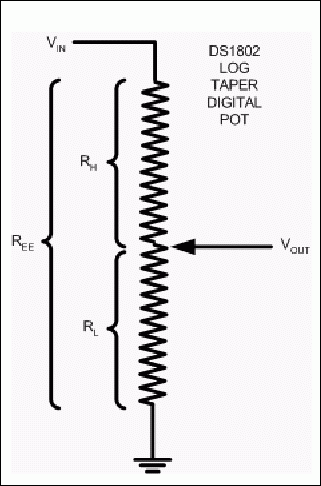
Abstract: The
DS1802 is a dual audio taper-po
ten
TIometer with logarith
mic resisTIve characterisTIcs over the device range. Each potenTIometer provides 65 wiper positions with a 1dB increment per step and device mute with at least 90dB of attenuation. The specifications given in this datasheet only refer to decibel measurements.
If a
designer wishes to calculate these values in ratiometric terms, a conve
rsion is necessary. This application note reviews the conversion from decibel to ratiometric. The formula is given in Excel as an example, for engineers wishing to build Excel tables de
picting g
ain calculations for the DS1802 and other audio potentiometers. While the DS1802 is given as an example, this application note pertains to any audio taper potentiometer.
免费注册参加在线研讨会,学习如何分析、测量并最终解决音频系统的设计问题 (English only) 。
OverviewThe DS1802 is a dual audio taper-potentiometer with logarithmic resistive characteristics over the device range. Each potentiometer provides 65 wiper positions with a 1dB increment per step and device mute with at least 90dB of attenuation. Table 1 shows the dB output as a function of the potentiometer wiper setting.
Table 1. DS1802 Gain (dB) as a Function of Wiper Setting - Resistance Characteristics
POSITION
OUTPUT LEVEL (dB)
0
0
1
-1
2
-2
3
-3
4
-4
5
-5
•
•
•
•
•
•
63
-63
64 (mute)
< -90
This chart only gives the output as a function of dB attenuation with reference to 0dB attenuation at the wiper 0 position. If the ratiometric output is desired, the ratio of the output signal relative to the input signal, a conversion must be made to convert dB to a ratiometric attenuation value.
dB attenuation is defined as 20 X LOG(VOUT/VIN).
The desired ratiometric output is defined as:
RL/REE = RL/(RL + RH) = VOUT/VIN
with RH = defined as the high-side of the DS1802, RL defined as the low side of the DS1802, REE defined as the end-to-end resistance, and VOUT and VIN defined as the output and input signals, respectively, as shown in Figure 1.

Figure 1. DS1802 block diag
ram (one potentiometer shown).
If we know the dB attenuation for a given potentiometer setting, we
can calculate the ratiometric output by solving for VOUT/VIN or:
the Ratiometric Output = INVERSE LOG10(dB attenuation/20). If one wanted to calculate the output signal ratiometrically as a function of the input in a spre
adsheet like Excel, no function for the inverse log function exists. As the INVERSE LOG function of X can be calculated as 10X, in Excel the power function can be used as follows: = (10)^(dB/20), where dB can be a value stored in another cell in the spreadsheet.
Table 2 below summarizes the ratiometric outputs available for the DS1802. While this example is given for the DS1802, it may be used in calculations to determine the ratiometric output of any LOG potentiometer.
Table 2. Ratiometric output of the DS1802 as a function of dB (Wiper) setting
dB Attenuation
Ratiometric Output
dB Attenuation
Ratiometric Output
0
1.00000
-32
0.02512
-1
0.89125
-33
0.02239
-2
0.79433
-34
0.01995
-3
0.70795
-35
0.01778
-4
0.63096
-36
0.01585
-5
0.56234
-37
0.01413
-6
0.50119
-38
0.01259
-7
0.44668
-39
0.01122
-8
0.39811
-40
0.01000
-9
0.35481
-41
0.00891
-10
0.31623
-42
0.00794
-11
0.28184
-43
0.00708
-12
0.25119
-44
0.00631
-13
0.22387
-45
0.00562
-14
0.19953
-46
0.00501
-15
0.17783
-47
0.00447
-16
0.15849
-48
0.00398
-17
0.14125
-49
0.00355
-18
0.12589
-50
0.00316
-19
0.11220
-51
0.00282
-20
0.10000
-52
0.00251
-21
0.08913
-53
0.00224
-22
0.07943
-54
0.00200
-23
0.07079
-55
0.00178
-24
0.06310
-56
0.00158
-25
0.05623
-57
0.00141
-26
0.05012
-58
0.00126
-27
0.04467
-59
0.00112
-28
0.03981
-60
0.00100
-29
0.03548
-61
0.00089
-30
0.03162
-62
0.00079
-31
0.02818
-63
0.00071
-32
0.02512
-64
MUTE
This ratiometric output can also be expressed as the ration of RL to REE (=RL/REE) so, as an example, the value of RL at a wiper setting of -21 dB would be 0.08913 x REE.



 微信扫一扫
微信扫一扫
 支付宝扫一扫
支付宝扫一扫
评论列表(0条)